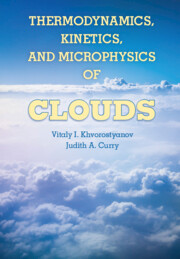Book contents
- Frontmatter
- Contents
- Preface
- 1 Introduction
- 2 Clouds and Their Properties
- 3 Thermodynamic Relations
- 4 Properties of Water and Aqueous Solutions
- 5 Diffusion and Coagulation Growth of Drops and Crystals
- 6 Wet Aerosol Processes
- 7 Activation of Cloud Condensation Nuclei into Cloud Drops
- 8 Homogeneous Nucleation
- 9 Heterogeneous Nucleation of Drops and Ice Crystals
- 10 Parameterizations of Heterogeneous Ice Nucleation
- 11. Deliquescence and Efflorescence in Atmospheric Aerosols
- 12 Terminal Velocities of Drops and Crystals
- 13 Broad Size Spectra in Clouds and the Theory of Stochastic Condensation
- 14 Analytical Solutions to the Stochastic Kinetic Equation for Precipitating Clouds
- References
- Notations
- Index
7 - Activation of Cloud Condensation Nuclei into Cloud Drops
Published online by Cambridge University Press: 05 September 2014
- Frontmatter
- Contents
- Preface
- 1 Introduction
- 2 Clouds and Their Properties
- 3 Thermodynamic Relations
- 4 Properties of Water and Aqueous Solutions
- 5 Diffusion and Coagulation Growth of Drops and Crystals
- 6 Wet Aerosol Processes
- 7 Activation of Cloud Condensation Nuclei into Cloud Drops
- 8 Homogeneous Nucleation
- 9 Heterogeneous Nucleation of Drops and Ice Crystals
- 10 Parameterizations of Heterogeneous Ice Nucleation
- 11. Deliquescence and Efflorescence in Atmospheric Aerosols
- 12 Terminal Velocities of Drops and Crystals
- 13 Broad Size Spectra in Clouds and the Theory of Stochastic Condensation
- 14 Analytical Solutions to the Stochastic Kinetic Equation for Precipitating Clouds
- References
- Notations
- Index
Summary
Introduction
As discussed in Chapter 6, the number of cloud drops is an important determinant of cloud optical properties and the formation of precipitation. In the initial stages of cloud formation, the number of cloud drops is directly related to the number of cloud condensation nuclei (CCN) activated. Drop activation schemes used prior to the 1990s were based mostly on Twomey’s (1959) power law for the concentration of drops Ndr activated on cloud condensation nuclei (CCN). This scheme is still applied in some atmospheric models. The drawback of Twomey’s parameterization is that Ndr is unlimited at high supersaturations and can exceed CCN concentration Na.
A substantial revision and intensive development of new cloud drop activation parameterizations and their effects on climate modeling began in the 1990s (see reviews in Charlson et al., 2001; Lohmann and Feichter, 2005; McFiggans et al., 2006; Svenningsson et al., 2006; IPCC, 2007; and in Chapter 6 of this book). Along with the analytical modifications of Twomey’s power law described in Chapter 6, parameterizations of drop nucleation have been developed using results from parcel models that are fit to various empirical functions of a few nondimensional parameters (Abdul-Razzak et al., 1998; Abdul-Razzak and Ghan, 2000, 2004; Fountoukis and Nenes, 2005; Ming et al., 2006). Saleeby and Cotton (2004) developed another approach consisting of lookup tables compiled from several thousand runs of a parcel model. A comparison of various recent parameterizations of drop activation and their performance was conducted by Ghan et al. (2011).
- Type
- Chapter
- Information
- Thermodynamics, Kinetics, and Microphysics of Clouds , pp. 241 - 288Publisher: Cambridge University PressPrint publication year: 2014



